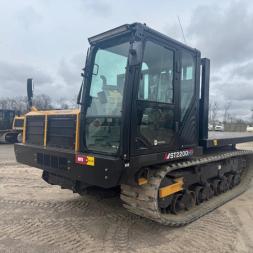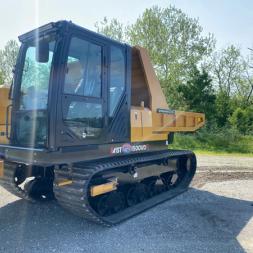

- Time Savings: Quick couplers significantly reduce the time required to change attachments, improving productivity and efficiency on the job site.
- Operator Convenience: With quick couplers, the operator can switch between various attachments without leaving the cab, providing greater comfort and convenience.
- Versatility: Couplers allow excavators to use a wide range of attachments, increasing the machine's versatility/profitability and making it suitable for multiple tasks.
- Safety: Quick couplers reduce the need for manual handling of heavy attachments, which can enhance safety by minimizing the risk of accidents and injuries.
- Compatibility: Many quick couplers are compatible with multiple brands and models of excavators, allowing for more flexible use of attachments across different machines.
- Versatility: Bucket attachments are versatile tools capable of handling various materials and tasks, making them essential for different construction and earthmoving projects.
- Efficiency: Buckets allow excavators to dig and move materials efficiently, reducing the manual labor required. Using the right bucket will save you time and money.
- Time Savings: Operators can quickly load and unload materials using buckets, improving overall project efficiency and timelines.
- Cost-Effectiveness: Bucket attachments are relatively inexpensive compared to other specialized attachments, making them a cost-effective solution for many tasks.
- Easy to Use: Bucket attachments are easy to install and use, and most excavator operators are familiar with their operation.
- Efficiency: Hammers can break through hard materials quickly, increasing productivity and efficiency in various construction and demolition tasks. They might be more expensive than a bucket, but even renting a hammer can save money on time and labor.
- Versatility: Hammers are versatile attachments suitable for breaking rock, concrete, and other dense materials.
- Reduced Vibration: Modern hammers are designed with dampening systems to reduce vibration and minimize strain on the excavator and the operator.
- Precise Control: Operators can precisely control the impact force and frequency of the hammer, allowing for accurate and controlled demolition work.
- Efficiency: Long thumbs are necessary if your machine has a quick coupler due to the added distance between the stick and bucket. A long thumb has added length to the tines to make up for the extra distance.
- Enhanced Grasping: Long thumbs provide a larger range of motion, enabling the excavator to securely grip and handle materials like logs, rocks, pipes, and irregularly shaped objects.
- Precise Control: Hydraulic control allows for fine adjustments, ensuring accurate positioning and secure gripping of materials.
- Increased Versatility: Long thumbs can be used in many ways, like sorting, stacking, and material handling.
- Efficiency: Short thumbs are used on machines not equipped with a quick coupler and allow the operator to handle objects like rocks, tree stumps, or irregularly shaped items.
- Precise Control: Hydraulic control allows for fine adjustments, ensuring accurate positioning and secure gripping of materials.
- Increased Versatility: Short thumbs can be used in many ways, like sorting, stacking, and material handling.
- Efficient Land Clearing: Rake attachments are an excellent choice for clearing vegetation, shrubs, small trees, and debris from construction sites or overgrown areas.
- Versatility: Rake attachments can handle various materials, making them suitable for multiple tasks, including land clearing, site preparation, storm cleanup, and agriculture.
- Selective Sorting: Rake attachments can selectively pick up and remove specific materials, making them useful in environmental restoration and habitat management projects.
- Breaking Hard Materials: Rippers are great at breaking up hard or compacted materials that standard digging buckets may struggle with.
- Cost-Efficient: Using a ripper attachment can save time and fuel by reducing the need for repeated digging attempts with a bucket.
- Versatility: Rippers can be used in various ways, including rock excavation, trenching in tough soil, and ripping up concrete, roots, or frozen ground.
- Preparation for Other Equipment: Ripping the ground can prepare it for other equipment or construction processes, such as blasting or additional excavation.
- Efficient Ditching: The curved design and extended width allow for faster and more efficient ditching, reducing the time and effort required for the task.
- Precise Shaping: Ditch-cleaning buckets can shape ditches more precisely, achieving the desired dimensions and slopes for adequate water flow.
- Reduced Material Loss: The higher back and heel of the bucket minimize material spillage during excavation, reducing the need for rework.
- Enhanced Drainage: Ditch-cleaning buckets help create well-formed ditches that improve water drainage, reducing the risk of flooding and erosion.
- Versatility: These buckets can serve a few purposes, such as ditch cleaning, grading, shaping embankments, and creating drainage channels.
- Fast and Efficient Clearing: Mulchers can clear large areas of vegetation quickly, making them highly efficient for land-clearing projects.
- Versatility: Mulchers can handle a wide range of vegetation, from dense underbrush to small trees.
- Environmentally Friendly: Mulching vegetation on-site returns organic material to the soil, promoting soil health. It also reduces the need for burning or transporting debris for disposal.
- Surface Restoration: Cold planers remove damaged or deteriorated surfaces, providing a clean and even base for repaving or overlaying.
- Accurate Milling: Cold planers offer precise milling control, allowing for accurately removing specific depth and width.
- Reduced Material Waste: Milling the surface rather than traditional removal methods minimizes material waste, making it a more eco-friendly process.
- Efficiency: Cold planers can quickly remove large areas of damaged pavement, speeding up road repairs.
- Cost-Effectiveness: Cold planers help extend the lifespan of existing roads by removing damaged layers and allowing for cost-effective repair and maintenance.
- Versatility: Brush mowers for excavators can handle a wide range of vegetation, including dense brush, small trees, saplings, and other tough vegetation.
- Efficiency: These attachments are highly efficient in quickly clearing large vegetation areas, making them suitable for land clearing and right-of-way maintenance projects.
- Accessibility: Excavator-mounted brush mowers can access clear vegetation in challenging terrain, steep slopes, and areas with limited ground access where traditional mowers might not operate.
- Mulching Capability: Brush is cut and mulched simultaneously into smaller pieces, which helps reduce the volume of vegetation and creates mulch that can decompose back into the soil.
- Safety: Clearing vegetation with a brush mower minimizes the risk of fire hazards and reduces the presence of potential hiding spots for pests and animals.
- Versatility: Pulverizers can handle various materials, including concrete, reinforced concrete, masonry, rocks, and other hard materials, making them versatile attachments for various demolition and construction tasks.
- Efficiency: The powerful crushing force of pulverizers allows for quick and efficient demolition of structures, reducing the time required for manual demolition methods.
- Reduced Waste: By breaking down large concrete pieces into smaller pieces, pulverizers reduce the volume of waste generated during demolition, making it easier to manage and dispose of the debris.
- Cost Savings: Using a pulverizer can save on disposal costs, as crushed materials can often be recycled or used on-site for fill material.
Date: 08.17.2023



















